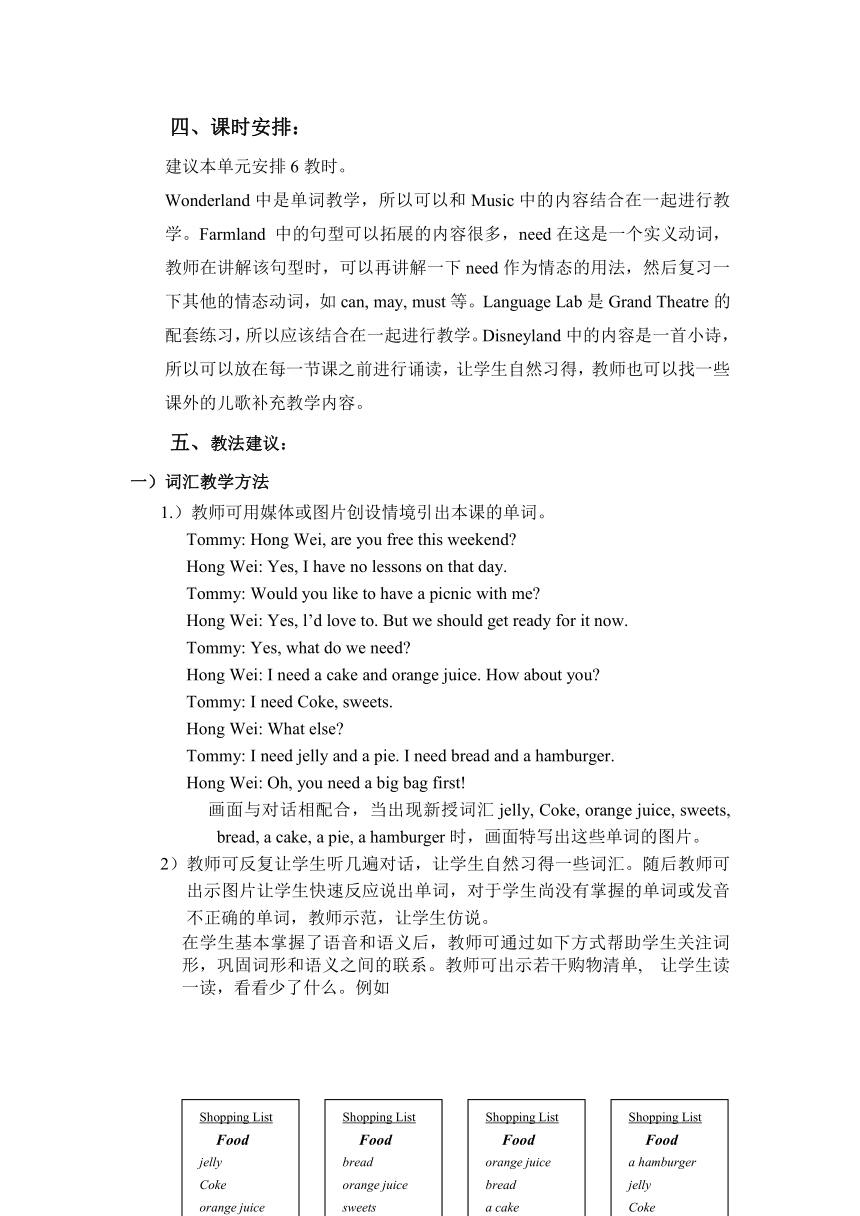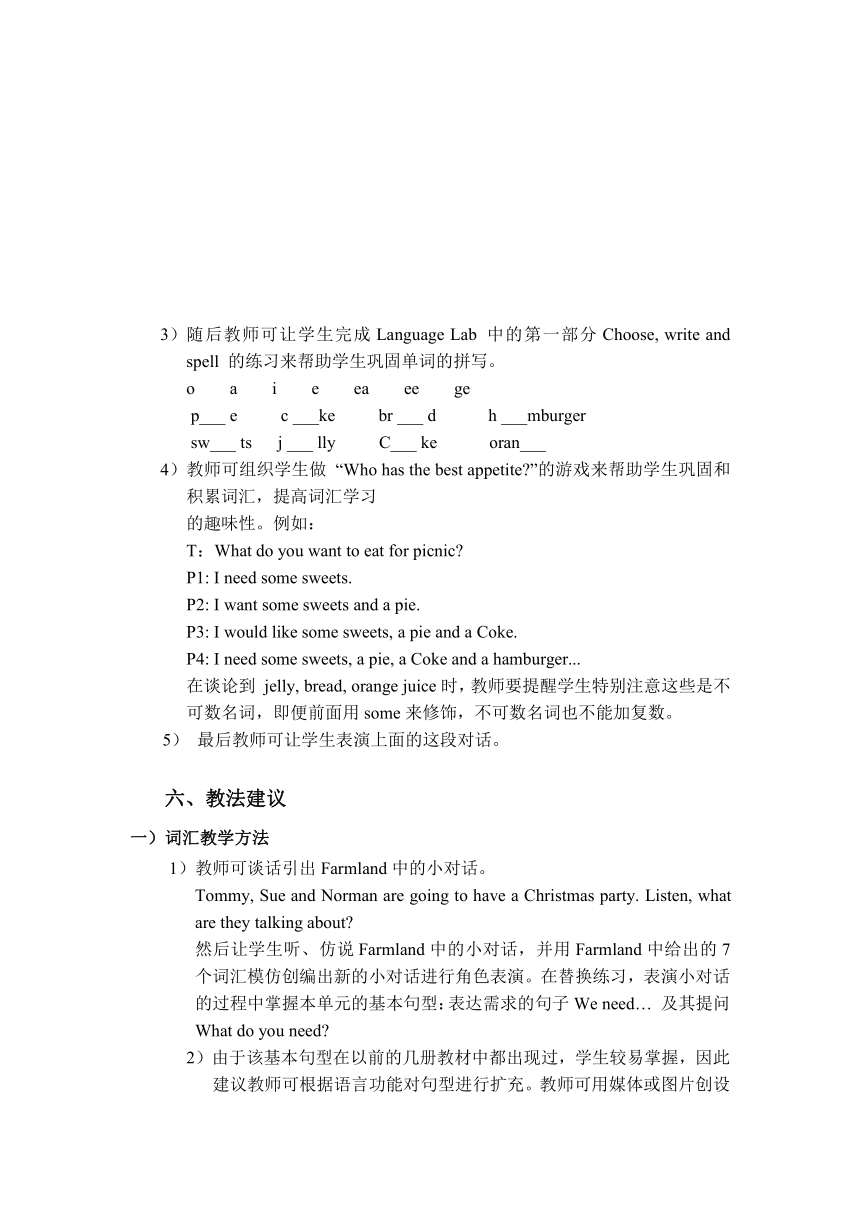(新世纪版)四年级英语上册教案 Unit 3
文档属性
| 名称 | (新世纪版)四年级英语上册教案 Unit 3 |

|
|
| 格式 | zip | ||
| 文件大小 | 20.2KB | ||
| 资源类型 | 教案 | ||
| 版本资源 | 新世纪版 | ||
| 科目 | 英语 | ||
| 更新时间 | 2012-03-13 19:43:32 | ||
图片预览



文档简介
新世纪版四年级英语上册
Unit 3 Getting Ready for a Picnic
一、教育目标:
1. 积极参加集体活动,在活动中让同学分享你的智慧和快乐。
2. 培养学生的独立意识和与他人合作的团队精神。
二、知识目标:
基础目标:
1)Wonderland:jelly Coke orange juice sweets bread a cake a hamburger a pie
2)Farmland: We need…
3)Grand Theatre:Getting Ready for a Picnic
4)Language Lab:能根据课文内容回答Questions and answers中的问题,根据自己的实际情况回答On your own中的问题。
5)Music Box:能掌握音标/k/,/g/,并能看音标读单词。
6)Disneyland:能掌握音标/k/,/g/,并能看音标读单词。
7)Difficult Points:
need作为实义动词和情态动词的区别:(教师把握好,不要给学生讲解得太复杂)
实义动词
I need a radio. I don’t need a radio.
You need to wash your hands. You don’t need to wash your hands.
情态动词
多用于否定和疑问结构,一般不用与肯定句。
Need you leave now Yes, I must. You needn’t call him again.
三、发展目标:
1.创设一个情境,鼓励学生整合已有的语言知识,分组进行小品表演“Getting Ready for a Picnic. ”。
2.写一篇与父母或朋友野营的小故事,在班级里进行交流,然后在班级展板中展出。
四、课时安排:
建议本单元安排6教时。
Wonderland中是单词教学,所以可以和Music中的内容结合在一起进行教学。Farmland 中的句型可以拓展的内容很多,need在这是一个实义动词,教师在讲解该句型时,可以再讲解一下need作为情态的用法,然后复习一下其他的情态动词,如can, may, must等。Language Lab是Grand Theatre的配套练习,所以应该结合在一起进行教学。Disneyland中的内容是一首小诗,所以可以放在每一节课之前进行诵读,让学生自然习得,教师也可以找一些课外的儿歌补充教学内容。
五、教法建议:
一)词汇教学方法
1.)教师可用媒体或图片创设情境引出本课的单词。
Tommy: Hong Wei, are you free this weekend
Hong Wei: Yes, I have no lessons on that day.
Tommy: Would you like to have a picnic with me
Hong Wei: Yes, l’d love to. But we should get ready for it now.
Tommy: Yes, what do we need
Hong Wei: I need a cake and orange juice. How about you
Tommy: I need Coke, sweets.
Hong Wei: What else
Tommy: I need jelly and a pie. I need bread and a hamburger.
Hong Wei: Oh, you need a big bag first!
画面与对话相配合,当出现新授词汇jelly, Coke, orange juice, sweets, bread, a cake, a pie, a hamburger时,画面特写出这些单词的图片。
教师可反复让学生听几遍对话,让学生自然习得一些词汇。随后教师可出示图片让学生快速反应说出单词,对于学生尚没有掌握的单词或发音不正确的单词,教师示范,让学生仿说。
在学生基本掌握了语音和语义后,教师可通过如下方式帮助学生关注词形,巩固词形和语义之间的联系。教师可出示若干购物清单, 让学生读一读,看看少了什么。例如
随后教师可让学生完成Language Lab 中的第一部分Choose, write and spell 的练习来帮助学生巩固单词的拼写。
o a i e ea ee ge
p___ e c ___ke br ___ d h ___mburger
sw___ ts j ___ lly C___ ke oran___
教师可组织学生做 “Who has the best appetite ”的游戏来帮助学生巩固和积累词汇,提高词汇学习
的趣味性。例如:
T:What do you want to eat for picnic
P1: I need some sweets.
P2: I want some sweets and a pie.
P3: I would like some sweets, a pie and a Coke.
P4: I need some sweets, a pie, a Coke and a hamburger...
在谈论到 jelly, bread, orange juice时,教师要提醒学生特别注意这些是不可数名词,即便前面用some来修饰,不可数名词也不能加复数。
5) 最后教师可让学生表演上面的这段对话。
六、教法建议
一)词汇教学方法
1)教师可谈话引出Farmland中的小对话。
Tommy, Sue and Norman are going to have a Christmas party. Listen, what are they talking about
然后让学生听、仿说Farmland中的小对话,并用Farmland中给出的7个词汇模仿创编出新的小对话进行角色表演。在替换练习,表演小对话的过程中掌握本单元的基本句型:表达需求的句子We need… 及其提问What do you need
2)由于该基本句型在以前的几册教材中都出现过,学生较易掌握,因此建议教师可根据语言功能对句型进行扩充。教师可用媒体或图片创设情境,从中引出表达需求的不同句型:
I need …
Give …, please.
…, please.
I’d like …
I want …
Narrator: Norman, Tim, Sue, Sandy, Julia and Peter are going autumn outing next week. They’ve got a lot of food in Mr White’s bag.
Tim: I’m thirsty. Give me some orange juice, please.
Mr White: OK, here you are.
Norman: I’m thirsty, too. Give me a Coke, please.
Mr White: OK, here you are.
Sandy: I’m hungry. A hamburger, please.
Mr White: OK, here you are.
Julia: I’m hungry, too. I’d like some bread.
Mr White: OK, here you are.
Peter: I’m thirsty and hungry. I need some water and a cake.
Mr White: OK, here you are.
Sue: I’m thirsty and hungry, too. I want an apple and a pie, please.
Mr White: There is only an apple pie!
画面与对话相配合。
教师可让学生反复听几遍对话。第一遍,只出现画面,不出现文字; 第二遍,出现对话的文字,主要句型用红色标注; 第三遍,教师可在观看对话的过程中引导学生仿说; 第四遍,教师可在对话放到主要句型时,适时地将对话的音量调小,让学生配音,了解学生对主要句型的习得情况。
让学生在听、仿说中逐步习得表示需求的多种表达方式。
对于四年级的学生,教师还可帮助学生掌握该句型的第三人称单数形式。教师可先让学生根据刚才的对话完成表格:
thirsty hungry orange juice water hamburger bread Coke cakes apple pie
Tim √ √
Norman √ √
Sandy √ √
Julia √ √
Peter √ √ √ √
Sue √ √ √ √
然后可给出学生model, 让学生模仿例句完成句子。
Model : Tim is thirsty. He needs some orange juice.
Julia is hungry. She needs some bread.
Norman is _________. He __________.
Sandy is ___________. He __________.
Peter is ___________. He __________.
Sue is _________. She __________.
__________________. ____________________
5) 随后,教师可让学生完成Project 1 Making a Shopping List
6)最后教师可让学生根据现实生活中的情境,整合已有的语言知识,自由创编和表演对话,让学生在尽可能生活化的语境中运用语言知识。例如,教师可创设Birthday Party的情景。
二)课文教学方法
教师可在Warming-up中让学生朗读Disneyland中的儿歌Hot Grey Peas, 然后自然引出下面的话题讨论。
What are they doing
What are they eating for the picnic
教师可先通过Language Lab中On your own中的问题让学生围绕着装展开话题讨论。
Do you like picnics
Where would you like to have a picnic
What do you need for your picnic
Have you got enough money for your picnic
在话题讨论中,教师可引出课文中的新句子What else
接着教师可从话题讨论中自然引出课文。Children will have a picnic. What do they need Have they got enough money for their picnic Let’s listen.
听完课文录音后,教师可通过让学生回答Language Lab的Questions and answers中的问题来了解学生对课文内容的理解程度。
When will they have a picnic
What do they need
What does Norman need
Do the children like picnics
在学生回答问题中自然引出新词组get ready for a picnic
在学生理解课文大意后,可让学生跟录音仿读课文。
教师可通过角色表演让学生在准交际情境中运用语言,并指导学生要表演出孩子们的兴奋的心情。
最后,教师可让学生整合已有的语言知识,以We need…为题写一个对话或是语段,提高学生的语用能力。
Shopping List
Food
a hamburger
jelly
Coke
orange juice
sweets
bread
Shopping List
Food
orange juice
bread
a cake
a pie
jelly
sweets
Shopping List
Food
bread
orange juice
sweets
a cake
Coke
a hamburger
Shopping List
Food
jelly
Coke
orange juice
bread
a cake
a pie
Unit 3 Getting Ready for a Picnic
一、教育目标:
1. 积极参加集体活动,在活动中让同学分享你的智慧和快乐。
2. 培养学生的独立意识和与他人合作的团队精神。
二、知识目标:
基础目标:
1)Wonderland:jelly Coke orange juice sweets bread a cake a hamburger a pie
2)Farmland: We need…
3)Grand Theatre:Getting Ready for a Picnic
4)Language Lab:能根据课文内容回答Questions and answers中的问题,根据自己的实际情况回答On your own中的问题。
5)Music Box:能掌握音标/k/,/g/,并能看音标读单词。
6)Disneyland:能掌握音标/k/,/g/,并能看音标读单词。
7)Difficult Points:
need作为实义动词和情态动词的区别:(教师把握好,不要给学生讲解得太复杂)
实义动词
I need a radio. I don’t need a radio.
You need to wash your hands. You don’t need to wash your hands.
情态动词
多用于否定和疑问结构,一般不用与肯定句。
Need you leave now Yes, I must. You needn’t call him again.
三、发展目标:
1.创设一个情境,鼓励学生整合已有的语言知识,分组进行小品表演“Getting Ready for a Picnic. ”。
2.写一篇与父母或朋友野营的小故事,在班级里进行交流,然后在班级展板中展出。
四、课时安排:
建议本单元安排6教时。
Wonderland中是单词教学,所以可以和Music中的内容结合在一起进行教学。Farmland 中的句型可以拓展的内容很多,need在这是一个实义动词,教师在讲解该句型时,可以再讲解一下need作为情态的用法,然后复习一下其他的情态动词,如can, may, must等。Language Lab是Grand Theatre的配套练习,所以应该结合在一起进行教学。Disneyland中的内容是一首小诗,所以可以放在每一节课之前进行诵读,让学生自然习得,教师也可以找一些课外的儿歌补充教学内容。
五、教法建议:
一)词汇教学方法
1.)教师可用媒体或图片创设情境引出本课的单词。
Tommy: Hong Wei, are you free this weekend
Hong Wei: Yes, I have no lessons on that day.
Tommy: Would you like to have a picnic with me
Hong Wei: Yes, l’d love to. But we should get ready for it now.
Tommy: Yes, what do we need
Hong Wei: I need a cake and orange juice. How about you
Tommy: I need Coke, sweets.
Hong Wei: What else
Tommy: I need jelly and a pie. I need bread and a hamburger.
Hong Wei: Oh, you need a big bag first!
画面与对话相配合,当出现新授词汇jelly, Coke, orange juice, sweets, bread, a cake, a pie, a hamburger时,画面特写出这些单词的图片。
教师可反复让学生听几遍对话,让学生自然习得一些词汇。随后教师可出示图片让学生快速反应说出单词,对于学生尚没有掌握的单词或发音不正确的单词,教师示范,让学生仿说。
在学生基本掌握了语音和语义后,教师可通过如下方式帮助学生关注词形,巩固词形和语义之间的联系。教师可出示若干购物清单, 让学生读一读,看看少了什么。例如
随后教师可让学生完成Language Lab 中的第一部分Choose, write and spell 的练习来帮助学生巩固单词的拼写。
o a i e ea ee ge
p___ e c ___ke br ___ d h ___mburger
sw___ ts j ___ lly C___ ke oran___
教师可组织学生做 “Who has the best appetite ”的游戏来帮助学生巩固和积累词汇,提高词汇学习
的趣味性。例如:
T:What do you want to eat for picnic
P1: I need some sweets.
P2: I want some sweets and a pie.
P3: I would like some sweets, a pie and a Coke.
P4: I need some sweets, a pie, a Coke and a hamburger...
在谈论到 jelly, bread, orange juice时,教师要提醒学生特别注意这些是不可数名词,即便前面用some来修饰,不可数名词也不能加复数。
5) 最后教师可让学生表演上面的这段对话。
六、教法建议
一)词汇教学方法
1)教师可谈话引出Farmland中的小对话。
Tommy, Sue and Norman are going to have a Christmas party. Listen, what are they talking about
然后让学生听、仿说Farmland中的小对话,并用Farmland中给出的7个词汇模仿创编出新的小对话进行角色表演。在替换练习,表演小对话的过程中掌握本单元的基本句型:表达需求的句子We need… 及其提问What do you need
2)由于该基本句型在以前的几册教材中都出现过,学生较易掌握,因此建议教师可根据语言功能对句型进行扩充。教师可用媒体或图片创设情境,从中引出表达需求的不同句型:
I need …
Give …, please.
…, please.
I’d like …
I want …
Narrator: Norman, Tim, Sue, Sandy, Julia and Peter are going autumn outing next week. They’ve got a lot of food in Mr White’s bag.
Tim: I’m thirsty. Give me some orange juice, please.
Mr White: OK, here you are.
Norman: I’m thirsty, too. Give me a Coke, please.
Mr White: OK, here you are.
Sandy: I’m hungry. A hamburger, please.
Mr White: OK, here you are.
Julia: I’m hungry, too. I’d like some bread.
Mr White: OK, here you are.
Peter: I’m thirsty and hungry. I need some water and a cake.
Mr White: OK, here you are.
Sue: I’m thirsty and hungry, too. I want an apple and a pie, please.
Mr White: There is only an apple pie!
画面与对话相配合。
教师可让学生反复听几遍对话。第一遍,只出现画面,不出现文字; 第二遍,出现对话的文字,主要句型用红色标注; 第三遍,教师可在观看对话的过程中引导学生仿说; 第四遍,教师可在对话放到主要句型时,适时地将对话的音量调小,让学生配音,了解学生对主要句型的习得情况。
让学生在听、仿说中逐步习得表示需求的多种表达方式。
对于四年级的学生,教师还可帮助学生掌握该句型的第三人称单数形式。教师可先让学生根据刚才的对话完成表格:
thirsty hungry orange juice water hamburger bread Coke cakes apple pie
Tim √ √
Norman √ √
Sandy √ √
Julia √ √
Peter √ √ √ √
Sue √ √ √ √
然后可给出学生model, 让学生模仿例句完成句子。
Model : Tim is thirsty. He needs some orange juice.
Julia is hungry. She needs some bread.
Norman is _________. He __________.
Sandy is ___________. He __________.
Peter is ___________. He __________.
Sue is _________. She __________.
__________________. ____________________
5) 随后,教师可让学生完成Project 1 Making a Shopping List
6)最后教师可让学生根据现实生活中的情境,整合已有的语言知识,自由创编和表演对话,让学生在尽可能生活化的语境中运用语言知识。例如,教师可创设Birthday Party的情景。
二)课文教学方法
教师可在Warming-up中让学生朗读Disneyland中的儿歌Hot Grey Peas, 然后自然引出下面的话题讨论。
What are they doing
What are they eating for the picnic
教师可先通过Language Lab中On your own中的问题让学生围绕着装展开话题讨论。
Do you like picnics
Where would you like to have a picnic
What do you need for your picnic
Have you got enough money for your picnic
在话题讨论中,教师可引出课文中的新句子What else
接着教师可从话题讨论中自然引出课文。Children will have a picnic. What do they need Have they got enough money for their picnic Let’s listen.
听完课文录音后,教师可通过让学生回答Language Lab的Questions and answers中的问题来了解学生对课文内容的理解程度。
When will they have a picnic
What do they need
What does Norman need
Do the children like picnics
在学生回答问题中自然引出新词组get ready for a picnic
在学生理解课文大意后,可让学生跟录音仿读课文。
教师可通过角色表演让学生在准交际情境中运用语言,并指导学生要表演出孩子们的兴奋的心情。
最后,教师可让学生整合已有的语言知识,以We need…为题写一个对话或是语段,提高学生的语用能力。
Shopping List
Food
a hamburger
jelly
Coke
orange juice
sweets
bread
Shopping List
Food
orange juice
bread
a cake
a pie
jelly
sweets
Shopping List
Food
bread
orange juice
sweets
a cake
Coke
a hamburger
Shopping List
Food
jelly
Coke
orange juice
bread
a cake
a pie
同课章节目录
- Unit 1 Teacher’s Day
- Unit 2 Hangman--A Spelling Game
- Unit 3 Getting Ready for a Picnic
- Unit 4 That Clock Doesn’t Work
- Unit 5 When Is Your Birthday?
- Unit 6 Norman’s Toys
- Unit 7 A Pretty Girl
- Unit 8 Give Me the Corn
- Unit 9 The Tiger and Other Animals
- Unit 10 In the Fruit Shop
- Unit 11 Let’s Go to a Movie
- Unit 12 Beautiful Butterflies
